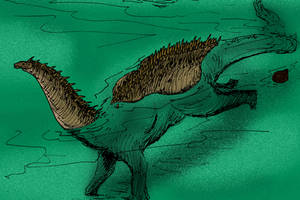Deviation Actions
Description
Arthrolamnia orca, or Betelgeuse’s Orca, is a kind of crustacean of the Order Lamnicariiforma, family Arthrolamnidae, from Betelgeuse-6, aka Kruupria.
With a maximum height greater than 2 m in length, it is one of the largest predators currently living in the Polar Sea of Kruupria.
He is considered a dangerous predator because he is responsible for violent attacks on natives, but the vast majority of them are non-fatal. Nevertheless, contrary to certain received ideas, he is not a "man-eater" and the man is not a prey for him, most of the attacks being due to an error of visual analysis or to attacks protection of its territory. Betelgeuse's Orca has a very varied diet : Ichthyocaris (insectoid fish), Fish (vertebrates), Pseudinsects, Crustaceans ...
He has a short, rounded muzzle with a long dorsal fin, which earned him the nickname "Orca".
Its mouthparts are composed in 3 parts : lateral maxillae, which protect the rest of the buccal appendages and also serve, to maintain the food (by the sides) ; the chelicerae, which are composed of three articles, two of which are distal, form a pincer, the mobile and fixed fingers possess teeth for mastication ; Finally, the labium with long labial palps, covered with long bristles, used to maintain the food (from below) and to catch any waste during chewing.
The tail of Arthrolamnidae consists of 6 swimming appendages, forming the Sternal fins. The last abdominal article ends with a soft caudal fin.
Apart from the dorsal fin and the pectoral fins, all the fins end with long spatulate bristles that promote the flexibility of the chitin fins.
During its larval stage (between 0 and 2 years), Arthrolamnidae look like flattened shrimps, with 6 long legs to walk on the bottom of the sea. During the last moult to reach adulthood, these legs atrophy and the fins begin to appear. This elaborate transformation takes several days to take place, which is why the animal hides in the deep sea for the realization.
The Betelgeuse’s Orca is found in the whole of the Polar Sea (in the North), most often near the current of cold water.
The species is slightly rarefied, especially near the coast, but has maintained a stable population since its abusive hunting was banned.
--------------------------------------------------------------------------------------------------------------------------------------
Arthrolamnia orca, ou Orque de Betelgeuse, est une sorte de Crustacé de l’Ordre des Lamnicariiforma, de la famille des Arthrolamnidae, originaire de Betelgeuse-6, alias Kruupria.
Avec une taille maximale supérieure à 2 m de long, c'est l'un des plus grands prédateurs vivant actuellement dans la Mer polaire de Kruupria.
Il est considéré comme un prédateur dangereux puisqu'il est responsable d'attaques violentes envers les autochtones, mais la grande majorité d'entre elles étant non mortelles. Néanmoins, contrairement à certaines idées reçues, il n'est pas un « mangeur d'hommes » et l'homme n'est pas une proie pour lui, la plupart des attaques étant dues à une erreur d'analyse visuelle ou à des attaques de protection de son territoire. L’Orque de Betelgeuse a une alimentation très variée : Ichthyocaris (poissons insectoïdes), Poissons (vertébrés), Pseudinsectes, Crustacés...
Il possède un museau court et arrondi, avec un long aileron dorsal, ce qui lui a valu le surnom d’« Orque ».
Ses pièces buccales sont composées en 3 parties : les maxilles latérales, qui protègent le reste des appendices buccaux et servent également, à maintenir la nourriture (par les côtés) ; les chélicères, qui sont composées de trois articles dont deux distaux forment une pince, les doigts mobiles et fixes possèdent des dents pour la mastication ; enfin, le Labium munie de longues palpes labiales, recouverts de longues soies, servant à maintenir la nourriture (par le dessous) et à attraper les éventuelles déchets lors de la mastication.
La queue des Arthrolamnidae se compose de 6 appendices natatoires, formant les Nageoires Sternales. Le dernier article abdominal se termine par une nageoire caudale souple.
À part l’aileron dorsal et les nageoires pectorales, toutes les nageoires se terminent par de longues soies spatulées qui favorisent la souplesse des nageoires de chitines.
Lors de son stade larvaire (entre 0 et 2 ans) les Arthrolamnidae ressemblent à des crevettes aplaties, munies de 6 longues pattes pour marcher sur le fond des mers. Lors de la dernière mue pour atteindre l’âge adulte, ces pattes s’atrophient et les nageoires commencent à apparaitre. Cette transformation élaborée prend plusieurs jours à s’opérer, c’est pourquoi, l’animal se cache dans les grand fond, pour la réalisée.
L’Orque de Betelgeuse se rencontre dans l’entièreté de la Mer Polaire (au Nord), le plus souvent, à proximité du courant d’eaux froides.
L’espèce c’est légèrement raréfiée, surtout à proximité des côtes, mais conserve une population stable, depuis que sa chasse abusive a été interdite.
--------------------------------------------------------------------------------------------------------------------------------------
This animal was inspired by several animals of the Earth ... shark, orca, crustaceans, etc ... but also, by some other creatures, like Sand Shark of Subnautica, which inspired the larval life of the Animal.
I am also inspired by the works of some DeviantArt Artists, such as:
Zippo4k ![]() for its "Arthrognaths" [zippo4k.deviantart.com/art/Art…
for its "Arthrognaths" [zippo4k.deviantart.com/art/Art…
CarrionTrooper ![]() for his "Snaiadi Bugfishes" [carriontrooper.deviantart.com/…
for his "Snaiadi Bugfishes" [carriontrooper.deviantart.com/…
And Preradkor ![]() for his "Aquatic Pescidons and Arthrognathans from Snaiad" [preradkor.deviantart.com/art/A…
for his "Aquatic Pescidons and Arthrognathans from Snaiad" [preradkor.deviantart.com/art/A…
Thanks again !
Wait, is this planet orbiting Betelguese as in the Red Supergiant Star?

































